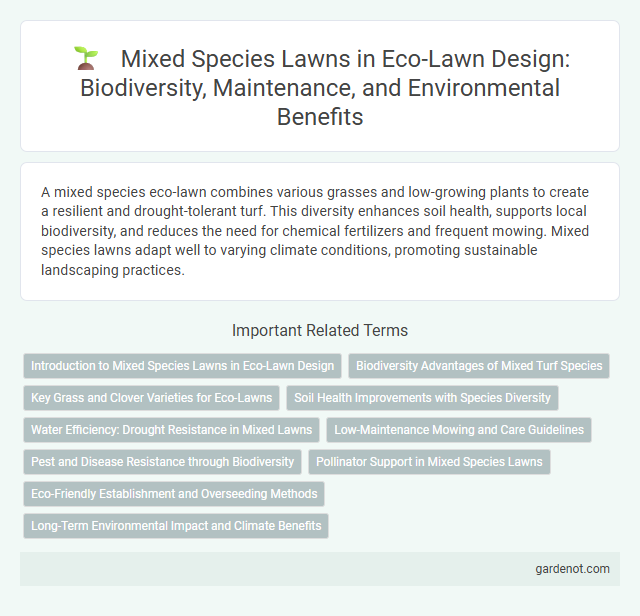A mixed species eco-lawn combines various grasses and low-growing plants to create a resilient and drought-tolerant turf. This diversity enhances soil health, supports local biodiversity, and reduces the need for chemical fertilizers and frequent mowing. Mixed species lawns adapt well to varying climate conditions, promoting sustainable landscaping practices.
Introduction to Mixed Species Lawns in Eco-Lawn Design
Mixed species lawns combine drought-tolerant grasses, native wildflowers, and clover to create a resilient and low-maintenance ground cover within eco-lawn design. These diverse plantings enhance soil health, support pollinators, and reduce the need for irrigation and chemical inputs. Integrating mixed species lawns promotes biodiversity and adapts well to varying environmental conditions while maintaining aesthetic appeal.
Biodiversity Advantages of Mixed Turf Species
Mixed species lawns enhance biodiversity by supporting a wider range of insects, birds, and soil organisms compared to monoculture turf. Diverse root structures improve soil health and nutrient cycling, promoting resilience against pests and environmental stress. Incorporating native and adaptive grass species fosters ecosystem balance and reduces the need for chemical inputs.
Key Grass and Clover Varieties for Eco-Lawns
Key grass varieties for eco-lawns include fine fescues like creeping red fescue (Festuca rubra) and chewings fescue (Festuca rubra subsp. commutata), known for drought tolerance and low maintenance. White clover (Trifolium repens) is a vital legume species that enriches soil nitrogen naturally, reducing the need for synthetic fertilizers. Combining these grasses and clover varieties fosters biodiversity, improves soil health, and promotes a resilient, eco-friendly lawn ecosystem.
Soil Health Improvements with Species Diversity
Mixed species eco-lawns promote soil health by enhancing microbial diversity and improving nutrient cycling. Incorporating various grass and legume species increases organic matter content and supports beneficial soil organisms, leading to better soil structure and water retention. This biodiversity reduces erosion and pest pressure, fostering a resilient and sustainable lawn ecosystem.
Water Efficiency: Drought Resistance in Mixed Lawns
Mixed species eco-lawns enhance water efficiency by incorporating drought-resistant grasses such as buffalo grass, blue grama, and fescues that require minimal irrigation. These diverse plant species establish deep root systems, improving soil moisture retention and reducing water runoff. Integrating multiple drought-tolerant varieties promotes resilience during dry periods, significantly lowering overall water consumption for lawn maintenance.
Low-Maintenance Mowing and Care Guidelines
Mixed species eco-lawns require minimal mowing, typically once every 2-3 weeks during peak growth periods to promote healthy turf density while conserving water. Selecting drought-tolerant grasses like fescue, bluegrass, and clover reduces the need for frequent irrigation and fertilizer application. Regular mowing at a height of 3 to 4 inches encourages deep root development and enhances resistance to weeds and pests.
Pest and Disease Resistance through Biodiversity
Mixed species eco-lawns enhance pest and disease resistance by combining diverse grasses and groundcovers that naturally deter harmful insects and pathogens. This biodiversity creates a resilient ecosystem where beneficial organisms thrive, reducing reliance on chemical pesticides. Varied root structures improve soil health, further strengthening the lawn's ability to withstand environmental stresses and disease outbreaks.
Pollinator Support in Mixed Species Lawns
Mixed species lawns enhance biodiversity by incorporating a variety of flowering plants that provide essential nectar and pollen resources for pollinators such as bees, butterflies, and hoverflies. These lawns support crucial pollination processes, promoting the health of local ecosystems and improving crop yields in surrounding areas. Diverse plant composition ensures continuous bloom periods, offering sustained food sources throughout the growing season for pollinator populations.
Eco-Friendly Establishment and Overseeding Methods
Mixed species lawns enhance eco-friendly establishment by combining drought-tolerant grasses like fine fescues, Kentucky bluegrass, and perennial ryegrass, which improve soil health and reduce water usage. Overseeding with native or adapted species promotes biodiversity, suppresses weeds naturally, and supports local pollinators, making lawn care sustainable and chemical-free. Utilizing slow-release organic fertilizers and appropriate mowing heights during overseeding further strengthens turf resilience and minimizes environmental impact.
Long-Term Environmental Impact and Climate Benefits
Mixed species eco-lawns enhance soil health by promoting biodiversity and improving carbon sequestration, which helps reduce greenhouse gas emissions over time. These diverse plantings increase resilience to drought and pests, minimizing the need for chemical fertilizers and irrigation. Their robust root systems support long-term carbon storage and improve water retention, contributing to climate change mitigation.
Mixed species lawn Infographic

 gardenot.com
gardenot.com